Whether you are building a new food plant, renovating or expanding an existing one, ensuring food sanitation and safety should be the number one concern. The incorporation of sanitary designs prevents the growth of microbes, ensures longer product shelf life, and reduces the chances of foodborne illnesses. This also lowers the risk of a recall and possible lawsuits from consumers.
If you are designing a new food plant or making changes to an existing one, working with food plant architects Stendel + Reich is beneficial. Experts are highly-qualified and well-versed in the fundamentals of sanitary design. They also know the food safety and sanitation regulations that constantly change. Adhering to these rules is essential to avoid legal issues.
Overlooked consideration: selection of the facility site
One of the most significant considerations for food plant sanitation that is often overlooked is the facility site selection. When choosing a location for your food plant, you must ensure that it is not close to sanitary landfills or areas where contamination can easily travel to the site.
These may also include refineries, chemical plants, raw sewage treatment facilities, and salvage yards. While accounting for the availability of labor, materials, and transportation, do not forget to make this consideration.
Choosing a location away from areas with higher contamination risks is one step towards maintaining a sanitary and clean facility. You won’t have to go the extra mile to clean the property’s surroundings.
Key questions when designing your food plant
- Which products will be made?
Before finalizing a food plant design, it is essential to determine whether you will be making raw, uncooked, cooked, or ready-to-eat (RTE) products. Also, design considerations for wet and dry are different.
- How will these products be made?
Determine the equipment and methods required to make the products in your food plant and how they will be packaged.
- How many zones of control will there be?
If your food plant contains different types of products, such as cooked, raw, and RTE, they will need to be stored in different areas to ensure hygiene. Different products will also need different humidity controls.
- Which chemicals will be used for cleaning the plant?
The food plant must be cleaned with the best cleaning materials. Therefore, ensure that the materials used to build the property and the equipment can withstand the harsh chemicals that will be used in the cleaning and sanitation process. Also, ensure no unclean product is mixed with clean products to avoid contamination risks.




